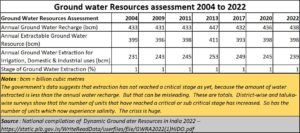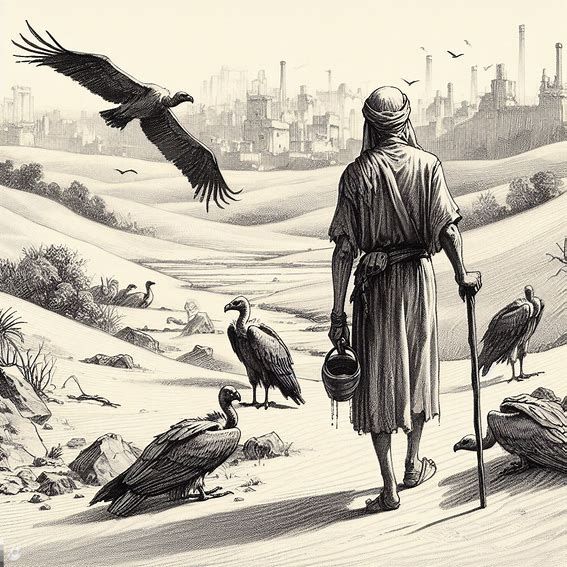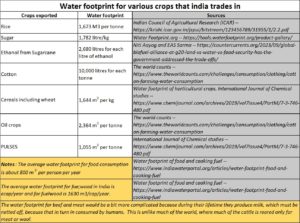A water policy is crucial for India’s survival
RN Bhaskar
The Bing generated image above could be prophetic. India – and the world – could soon be in desperate search of water. India will feel the pain much more than the world, because it does not have a water policy. It misuses and abuses water. Yes, the government has created a separate ministry for water. But the data is missing. You cannot solve a problem till you first have the numbers to know what to fix. You then encourage discussions on how to fix the problem. It won’t be long before India could see vultures circling overhead.
Some of the data in the tables here, have been culled from various places. They ought to have been there on the website of the Ministry of Water Resources (https://jalshakti-dowr.gov.in/). There is little to show that India has been blessed with more water than most countries. And in spite of that, this country has muffed things up.
India has more water than most other countries. Look at the neighbourhood. India has 9.6 % of its land mass under water. China has just 2.8% – very similar to Nepal, and Pakistan. One reason why China is one of the most efficient users of water in the world – at part with, or even better than Israel – is because it has to make do with little water.
Sri Lanka is a bit better off with 4.6% of its land mass covered with water. Bangladesh is luckier. But when you look at its population, it is remarkable that it has managed so well, and even achieving a per capita income which has just edged above that of India. The only country which is luckier than India is Russia – with 13% of its land mass under water. And remember that its land mass is nine times the sizew of India, and twice the size of the US.
But India misuses and abuses the water it gets. It spends a lot of money in attempting to clean up the Ganges, without first stemming the sources of effluents and waste that continue to pollute the river (https://asiaconverge.com/2020/08/government-plunder-productive-states-in-india/). The Yamuna is even more polluted. From a distance it looks like it is covered with snow, which is nothing but froth from the pollutants that continue to pour into it (https://asiaconverge.com/2019/07/water-and-waste-water-in-india/).
In November 2019, this author did a series of articles on water and what should be done to ameliorate the water situation in India (https://asiaconverge.com/2019/07/the-water-series/). The government has not woken up as yet.
First look at some signs that are flashing red. The water ministry’s website possibly does not think that this is worth pointing out to Indians.
India has continued to draw on ground water reserves because of several reasons. Two of them are irrigation and freebies.
India has little of its land irrigated, even 75 years after independence. Rare exceptions exist, but by and large only 33.5% of India’s land mass is irrigated (free subscription — https://bhaskarr.substack.com/p/myopic-sugar-and-ethanol-policies). That compels local folk to resort to borehole drilling, to extract water for drinking, washing and for their crops.
The second reason is freebies. The government may rail against the revadi culture. But do remember that it was this government which reintroduced this culture in Uttar Pradesh shortly before elections, after persuading the country not to go in for loan writeoffs when it came to power in 2014.
Water is not taxed for rural communities. Water consumption is not even measured. There are no water meters. Over and above that, almost every state government provides electricity for free or almost-free. When farmers have a combination of both, it is not uncommon to see them leaving their pumpsets on for longer than required.
There is a third reason. The government has yet to introduce measures that tax farmers (and consumers) who use more than their allotted share of water, or those who do not use methods that minimise water consumption. Water ‘quotas’ could be fixed depending on the tuype of crop that is growth, and the country’s requirement for a specific crop for food security. Drip irrigation has been popularised in patches, not across the country. New varieties of rice that consume 40% less water (https://www.bayer.com/media/en-us/bayer-introduces-agricultural-system-for-direct-seeded-rice-with-potential-to-reduce-greenhouse-gas-emissions-and-water-use-by-up-to-40-percent/) have not been popularised adequately. That needs to be done on a war footing.

 One problem with the government is that it chooses the figures it wants to show. For instance, the first table above shows that the situation is not as alarming as is made out to be. The total water extraction is less that the total water recharged. But that can be a very misleading picture.
One problem with the government is that it chooses the figures it wants to show. For instance, the first table above shows that the situation is not as alarming as is made out to be. The total water extraction is less that the total water recharged. But that can be a very misleading picture.
For learning about how great the crisis is, it is important to look at the second chart. The numbers suggest why some governments have begun promoting dealination projects for drinking water. Such projects aren’t necessary, if the government manages water utilisation properly (https://asiaconverge.com/2019/08/desalination-is-a-money-game-in-india/). Instead, these projects will make common tax payers paying for the policymakers’ misgovernance. These costs could go higher, because already there is a clamour from vested interest parties to privatise water supply.
Water footprints and exports
The biggest area of con ern should be blind eye that the government has shown to the water footprint issue (https://asiaconverge.com/2019/07/how-india-forgot-its-water-footprint/).
Take the case of the biggest agriculture exports (https://agriwelfare.gov.in/en/AgricultureTrade). According to the data provided by the government, “As compared to previous year (2020-21), the Agri and Allied exports in the year 2021-22increased by 20.79% to Rs. 3,74,611.64 crores.” Principal items that were exported in 2021-22 were rice (Rs. 45,725 crore plus Rs. 26,590 crore for Basmati), sugar (Rs. 34,345 crore), spices (Rs. 29,039 crore), beef (Rs. 24,613 crore), cotton (Rs.21,007 crore), and wheat (Rs. 15,845 crore).
That looks good. But India has not done its homework about the actual profit or loss from exports because it has not considered the water footprint.
Every product, even stainless steel, requires water in its production process. This is especially true of agricultural crops. They need water from the time the seeds are planted, to the time they are harvested, cleaned, processed and made ready for consumption (more about the water footprint can be found at https://asiaconverge.com/2019/07/how-india-forgot-its-water-footprint/). The total water that is used during the life cycle of a product is called the water footprint.
The water footprint for any item can change from one country to another, and even from district to district within the same country. This is because the rates of water evaporation, the agricultural practices prevalent in a region within a country, the way a product is cleaned and processed are all factors that determine the water footprint. Hence the table used has water footprints that are the global average. In India the water footprint could be higher – except in the case of beef – because of higher evaporation rates, wasteful practices when it comes to using water, and poor storage conditions requiring the crop to be cleaned before actual sale.
In the case of beef, the milk that cows and buffaloes produce is consumed by people. That in turn reduces demand for water. A great deal of netting off must be done in India, unlike in many other countries where cattle is reared only for its meat. Secondly, in India, much of the fodder comes from plants which are grown for providing food for human beings. In many other countries, fodder must be grown exclusively for grazing animals.
But even the global averages should give policy makers enough cause for worry. There are some important questions that demand answers.
Questions
Should India be exporting so much of rice and sugar (and ethanol) if the water footprints are so huge for these items?
Rice requires 1,673 cubic metres of water for producing just one tonne of this grain. If we were to take the cost of water, and then look at the amount of subsidy rice gets in its final pricing, shouldn’t that subsidy get reflected in the export price as well? What is the economic cost or benefit when one uses so much of (unpriced) water along with subsidised fertiliser as a gift to other countries? Could that explain why savvy countries with little water prefer to import rice rather than grow it all themselves?
Ditto for sugar which requires 1,782 litres of water for every kg of this item. In fact, the issues surrounding sugar are even more complex. Sugar uses water that is free. The state gives a subsidy to sugar mills – especially to sugar cooperatives in Maharashtra and Karnataka (free subscription — https://bhaskarr.substack.com/p/myopic-sugar-and-ethanol-policies). Then there is the export subsidy which the government gives to this industry to make India’s exports competitive. So, has the government made public the actual costs incurred when exporting sugar or ethanol? That is why, policy analysts like EAS Sarma, former finance secretary with the government of India, insists that the country needs to work on clear policies relating to water consumption (https://countercurrents.org/2023/09/global-biofuel-alliance-at-g20-land-vs-water-vs-food-security-has-the-government-addressed-the-trade-offs/).
That is why it is alarming to see little or none of this data featuring on the website of the Ministry of Water Resources.
Is it because the government does not want serious issues to be discussed? Or is there something that the government would like to conceal? Or is it merely a case of sloth?
Answers are needed urgently. Climate change, increasing aridity of soil, and depletion of groundwater resources are compelling reasons for this information to be made public.








































COMMENTS